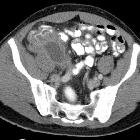perforierte Appendizitis













A perforated appendix is one of the complications of acute appendicitis. When appendicitis is left untreated, necrosis (gangrene) of the appendiceal wall can occur and progress to a focal rupture.
Epidemiology
Perforation of the appendix is more common with advanced age, due to an increased frequency of late and atypical presentation of appendicitis, delay in diagnosis, delayed decision for surgery, and to the age-specific physiological changes .
Clinical presentation
A slight majority of patients with a perforated appendicitis present more than 48 hours after symptom onset .
Pathology
Intraoperative or gross pathology examination reveals a full-thickness defect in the appendiceal wall. Histopathology demonstrates neutrophilic infiltration and transmural necrosis with extensive mucosal ulceration (gangrenous acute appendicitis).
Radiographic features
CT
Computed tomography can predict perforation with high specificity (95%) in patients with known appendicitis when certain findings are present :
- focal defect in the enhancing appendiceal wall (most sensitive finding but its performance is heterogeneous across studies )
- periappendiceal abscess
- extraluminal gas (contained locules or free intraperitoneal gas)
- extraluminal appendicolith
- extraluminal leak of enteric contrast
Less specific findings include
Ultrasound
Although ultrasound is less accurate than a contrast-enhanced CT, the findings can be appreciated in experienced hands. Diagnosis of perforated appendix relies mainly on demonstration of right iliac fossa abscess or phlegmon in association with signs of appendiceal inflammation and appendicolith.
Treatment and prognosis
Management of perforated acute appendicitis depends on the clinical stability of the patient and the presence of an abscess. Perforated appendix increases the risk of a postoperative abscess. If the patient is unstable or septic, urgent surgery is indicated. If the patient is stable, however, initial nonoperative management including antibiotics is safe . If an abscess is present, imaging-guided percutaneous drainage is prudent. Appendectomy should eventually be performed (unless comorbidities contraindicate elective surgery) to exclude an appendiceal neoplasm and prevent recurrent appendicitis.
Differential diagnosis
- pelvic inflammatory disease/tubo-ovarian abscess
- terminal ileitis with abscess formation (e.g. Crohn disease)
- cecal diverticulitis
- epiploic appendagitis
- perforated cecal and appendiceal carcinoma
Siehe auch:
- perityphlitischer Abszess
- Appendizitis
- Appendizitis Sonographie
- Appendizitis mit Abszess
- nekrotisierende Appendizitis
und weiter:

 Assoziationen und Differentialdiagnosen zu perforierte Appendizitis:
Assoziationen und Differentialdiagnosen zu perforierte Appendizitis:



